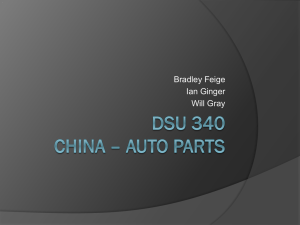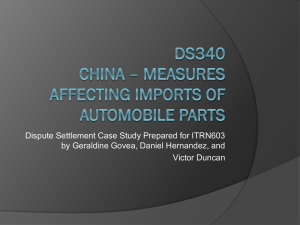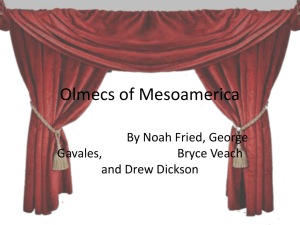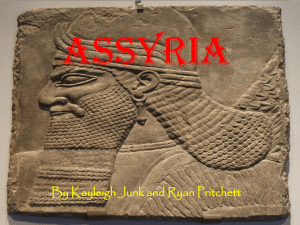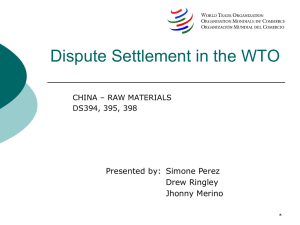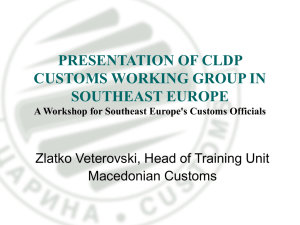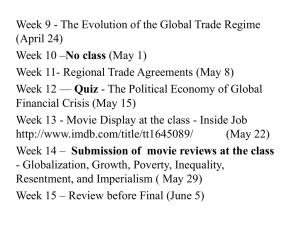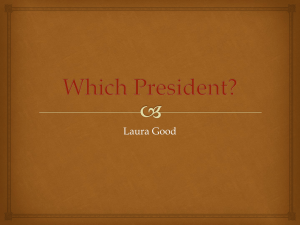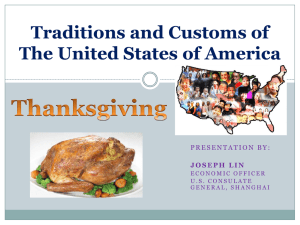III. History of the Economic and Monetary Policy of the EC/EU
advertisement
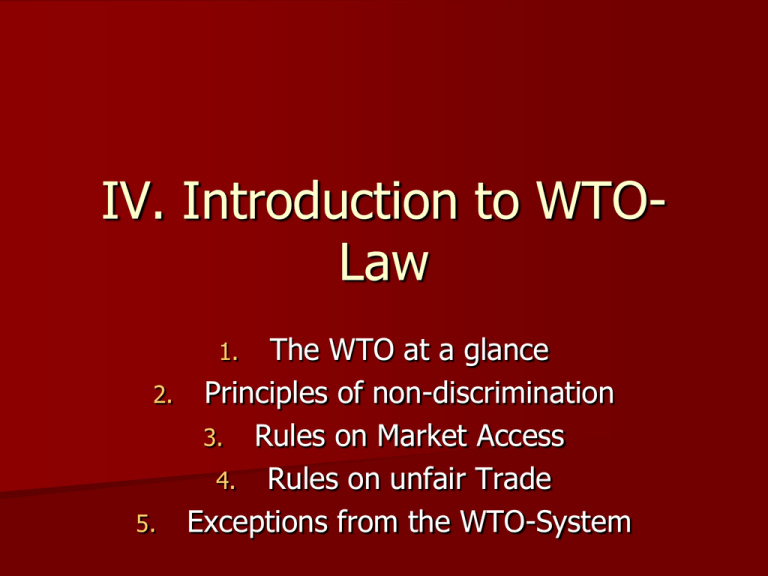
IV. Introduction to WTOLaw
The WTO at a glance
2. Principles of non-discrimination
3. Rules on Market Access
4. Rules on unfair Trade
5. Exceptions from the WTO-System
1.
1. The WTO at a glance
The agreement provides a common institutional
framework for the conduct of international trade relations.
Contrary to its predecessor the WTO is a permanent
organisation which benefits from a legal personality.
Objectives of the WTO
Raising standards of living
Ensuring full employment and a growing volume of real income and effective demand
Expanding the production of trade in goods and services
Sustainable development and protection of the environment
Needs of developing countries
Functions of the WTO
Facilitate the implementation, administration and operation of the various trade agreements
Provide a forum for multilateral trade negotiations
Resolve trade disputes (DSB)
Review national trade policies (TPRM)
Cooperate with IO
Structure of the WTO
© www.wto.org
Multilateral agreements on trade in goods:
the General Agreement on Tariffs and Trade 1994 ('GATT' 1994)
(which included the GATT 1947);
the Agreement on Agriculture;
the Agreement on the Application of Sanitary and Phytosanitary Measures;
the Agreement on Textiles and Clothing;
the Agreement on Technical Barriers to Trade;
the Agreement on Trade-Related Investment Measures;
the Agreement on Anti-Dumping Measures;
the Agreement on Customs Valuation;
the Agreement on Preshipment Inspection;
the Agreement on Rules of Origin;
the Agreement on Import Licensing Procedures;
the Agreement on Subsidies and Countervailing Measures;
the Agreement on Safeguards.
Multilateral agreement on Trade in Services (GATS)
Multilateral agreement on Trade-Related aspects of
Intellectual Property Rights (TRIPS)
Plurilateral Agreements
Agreement on Trade in Civil Aircraft
Agreement on Government Procurement
Understanding on Rules and Procedures Governing
the Settlement of Disputes (DSU)
Mechanism for reviewing the trade policies of WTO
members (TPRM)
General rules (e.g.
scope, functions,
organisation, accession)
DSU, TPRM
GATT
+ special
agreements
on
agriculture,
dumping,
subsidies
GATS
Plurilateral agreements:
TRIPS
public procurement, civil aircraft
2. Principles of nondiscrimination
2.1. Overview
Non-discrimination is the key concept of WTO-law and policy:
Discriminations are an important contributing cause of economic crises
Discrimination breeds resentments among countries, manufacturers,
traders, workers and poisons international relations and/or may lead to
conflict
Discrimination makes no or scant economic sense, since it distorts the
markets in favour of products or services that may be more expensive and
of a lesser quality.
1.
2.
Two main principles of non-discrimination (between and against
other countries) concerning trade in goods and services:
MFN: most-favoured-nation treatment obligation (2.2.)
National treatment obligation (2.3.)
2.2. MFN-principle
2.2.1. Overview
Cornerstone and one of the pillars of the WTO trading system
(Appellate Body, EC-Tariff Preferences, para 101)
Main Provision: Article I GATT ‘94 (General Most-Favoured-Nation
Treatment, s also II GATS and Art 4 TRIPS):
“1. With respect to customs duties and charges of any kind imposed on or
in connection with importation or exportation or imposed on the
international transfer of payments for imports or exports, and with respect
to the method of levying such duties and charges, and with respect to all
rules and formalities in connection with importation and exportation, and
with respect to all matters referred to in paragraphs 2 and 4 of Article III,
any advantage, favour, privilege or immunity granted by any
contracting party to any product originating in or destined for any
other country shall be accorded immediately and unconditionally
to the like product originating in or destined for the territories of
all other contracting parties.”
Further provisions of GATT ‘94 requiring MFN- or MFN-like treatment:
Art III (7) (internal quantitative regulations), Art V (freedom of transit), Art III (7) (internal
quantitative regulations), Art V (freedom of transit), Art IX (1) (marking requirements)
Art. I:1 prohibits discrimination between like products originating in, or
destined for, different countries. Purpose: equality of opportunity to
import from, or to export to, all WTO-members. S also Appellate Body
in EC-Bananas III, para 190: “The essence of the non-discrimination
obligations is that like products should be treated equally irrespective of
their origin. As no participant disputes that all bananas are like products,
the non-discrimination provisions apply to all imports of bananas,
irrespective of whether and how a Member categorizes or subdivides these
imports for administrative or other reasons.”
Art. I:1 covers not only in law/de jure discrimination but also in fact/de
facto discrimination. Even measures that are “origin neutral” can give
certain countries more opportunity to trade than others and can therefore
be in violation of Art. I:1.
Example: EEC-Imports of Beef: An EC-regulation was making the
suspension of an import levy conditional (only) on the production of a
certificate of authenticity. Formally speaking there were no restrictions on
the origin of beef, the regulation was de jure origin neutral. The GATTPanel found that this regulation was nevertheless inconsistent with the
MFN-obligation of Art. I:1 after it was established that the only
certifying agency authorised to produce such a certificate of authenticity
was an agency in the USA.
2.2.2. Three tier test of Article I:1
GATT’94
Three tier test of consistency:
1. Is the measure at issue conferring a trade “any
advantage” of the kind covered by Art. I:1?
2. Are the products concerned “like products”?
3. Is the advantage at issue granted
“immediately and unconditionally” to all like
products concerned?
“Any Advantage” (1)
The MFN obligation concerns any advantage granted by any
Member to any other WTO-Member or Non-WTO-Member (!)
with respect to (1) customs duties, other charges on imports and
exports and other customs matters (2) internal taxes (3) internal
regulation affecting sale, distribution and use of products. Generally
Art I:1 is very wide.
Examples: besides customs duties: import surcharges, customs
fees or quality inspection fees, charges on international transfer of
payments for imports/exports, method of assessing base value on
which the duty or charge is levied, internal taxes and internal
charges, etc.
“Like products” (2)
The MFN obligation concerns any product originating or destined for any
other country and requires that an advantage granted to these products
shall be accorded to all “like products” originating in or destined for the
territories of all other Members. A discrimination of like products is
thus prohibited. Unlike products may be treated differently.
Interpretation of “like” is difficult (“like” can have different meanings).
Example: GATT-Panel, Spain – Unroasted Coffee: Spain did not apply
customs duties on “Colombia mild” and “other mild”, but it imposed them
on other types of unroasted coffe (e.g. “unwashed Arabica”). Brazil, which
exported mainly “unwashed Arabica”, claimed that the Spanish tariff regime
was inconsistent with Art. I:1. The Panel noted that these were considered
to be "like products“ –regarding their characteristics, their end-use and
the tariff regimes of other Members -, the Panel concluded that the tariff
régime as presently applied by Spain was discriminatory vis-à-vis unroasted
coffee originating in Brazil.
In general PPM (process or production method) are not relevant. Thus
products produced in an environmentally friendly manner and those
produced in an environmentally unfriendly manner can not be treated
differently.
Advantage granted “immediately and unconditionally” (3)
The MFN obligation requires that any advantage granted by a WTO
Member to imports from any country must be granted “immediately
and unconditionally” (no “giving something in return”) to imports
from all other WTO Members.
Example: Appellate Body, Canada – Autos, para 85: “The measure
maintained by Canada accords the import duty exemption to certain
motor vehicles entering Canada from certain countries. These
privileged motor vehicles are imported by a limited number of
designated manufacturers who are required to meet certain
performance conditions. In practice, this measure does not accord
the same import duty exemption immediately and unconditionally to
like motor vehicles of all other Members, as required under
Article I:1 of the GATT 1994. The advantage of the import duty
exemption is accorded to some motor vehicles originating in certain
countries without being accorded to like motor vehicles
from all other Members. Accordingly, we find that this measure is
not consistent with Canada's obligations under Article I:1 of the
GATT 1994.”
2.3. National Treatment
2.3.1. Overview
Art III GATT’ 94 (s also Art. XVII GATS, Art 3 TRIPS):
“ 1. The contracting parties recognize that internal taxes and other internal charges,
and laws, regulations and requirements affecting the internal sale, offering
for sale, purchase, transportation, distribution or use of products, and
internal quantitative regulations requiring the mixture, processing or use of
products in specified amounts or proportions, should not be applied to imported or
domestic products so as to afford protection to domestic production.
2. The products of the territory of any contracting party imported into the territory of any
other contracting party shall not be subject, directly or indirectly, to internal
taxes or other internal charges of any kind in excess of those applied,
directly or indirectly, to like domestic products. Moreover, no contracting party
shall otherwise apply internal taxes or other internal charges to imported or domestic
products in a manner contrary to the principles set forth in paragraph 1. […]
4. The products of the territory of any contracting party imported into the territory of any
other contracting party shall be accorded treatment no less favourable than that
accorded to like products of national origin in respect of all laws, regulations and
requirements affecting their internal sale, offering for sale, purchase,
transportation, distribution or use. The provisions of this paragraph shall not prevent
the application of differential internal transportation charges which are based
exclusively on the economic operation of the means of transport and not on the
nationality of the product.”
Does not apply to laws/acts governing government procurement and subsidies.
Other National Treatment obligations can be found in the TBT
Agreement, the SPS Agreement and the Agreement on TradeRelated Investment Measures.
Purpose: Art III prohibits discrimination against imported
products. Imported products must not be treated less favourably
than like domestic products once the imported product has entered
the domestic market.
S Appellate Body, Japan Alcoholic Beverages II: “The broad and
fundamental purpose of Article III is to avoid protectionism in the
application of internal tax and regulatory measures. More
specifically, the purpose of Article III ‘is to ensure that internal
measures not be applied to imported or domestic products so as to
afford protection to domestic production’. Toward this end, Article
III obliges Members of the WTO to provide equality of
competitive conditions for imported products in relation to
domestic products. ‘[T]he intention of the drafters of the Agreement
was clearly to treat the imported products in the same way
as the like domestic products once they had been cleared
through customs. Otherwise indirect protection could be given’.
Art. III only applies to internal measures, not border measures
(like Art. II, tariff concessions or Art. XI, quantitative restrictions).
Distinction between internal and border measures is crucial.
Not always easy, esp. when the internal measure is applied to
imported products at the time or point of importation. E.g. a
product is barred at the border because it fails to meet a public
health or consumer safety requirement (in this case Art. III is
applicable)
Example: India – Autos: India imposed an obligation on
automotive manufacturers to (1) use a certain proportion of local
parts and components in the manufacture of cars and other
automotive vehicles and it also imposed an obligation (2) to offset
the amount of their purchases of previously imported kits and
components, already on the Indian market, by exports of equivalent
value. Furthermore it imposed an obligation on these manufacturers
to (3) balance their importation of kits and components with
exports of equivalent value.
India – Autos (cont’d): The DSB found that (1) and (2) were
inconsistent with Art III:4. Furthermore India acted inconsistently
with Article XI by imposing (3) on automotive manufacturers.
S Panel, India – Autos, para 8.1:
India acted inconsistently with its obligations under Article III:4 of
the GATT 1994 by imposing on automotive manufacturers, under
the terms of Public Notice No. 60 [...] an obligation to use a certain
proportion of local parts and components in the manufacture of cars
and automotive vehicles ("indigenization" condition);
India acted inconsistently with its obligations under Article XI of the
GATT 1994 by imposing on automotive manufacturers an obligation
to balance any importation of certain kits and components with
exports of equivalent value ("trade balancing" condition);
India acted inconsistently with its obligations under Article III:4 of
the GATT 1994 by imposing, in the context of the trade balancing
condition an obligation to offset the amount of any purchases
of previously imported restricted kits and components on the
Indian market, by exports of equivalent value.”
2.3.2. Art III:1, Art III:2 and Art III:4
Art. III:1 general principle which is elaborated by Art. III:2
(internal taxation) and Art III:4 (internal regulation).
Art. III:2:
First sentence: obligation relating to internal taxation of “like
products”
Second sentence: obligation relating to internal taxation of
“directly competitive or substitutable products” (competition
has to be involved).
Effect: S Appellate Body, Canada – Periodicals: First check sentence
1 – if it does not apply then check sentence 2
“ […] the following two questions need to be answered to determine whether there is a violation of
Article III:2 of GATT 1994: (a) Are imported "split-run" periodicals and domestic non "split-run"
periodicals like products?; and (b) Are imported "split-run" periodicals subject to an internal tax in
excess of that applied to domestic non "split-run" periodicals? If the answers to both questions
are affirmative, there is a violation of Article III:2, first sentence. If the answer to the first
question is negative, we need to examine further whether there is a violation of Article
III:2, second sentence.”
Art. III:2 first sentence: obligation
relating to internal taxation of “like
products”: Three-tier-test:
1. Are the measures internal taxes and
other charges of any kind, which are
applied directly or indirectly
2. are the imported and the domestic
products are like products?
3. Are the imported products are taxed in
excess of the domestic products?
(1) Internal taxes (=fiscal measure) which are applied “on or in
connection” (directly, indirectly=tax is applied on the processing of the
product. No fiscal measure: security deposit (EEC-Animal Feed Proteins)
(2) Like product: Example (Japan – Alcoholic Beverages II): Under the
Japanese tax system the internal tax imposed on domestic shochu
(alcoholic beverage) was the same as that imposed on imported shochu. A
higher tax was imposed on imported vodka (but the same as on domestic
vodka). The question was, if shochu and vodka were found to be like.
The Appellate body ruled that “like products” in the meaning of Art III:2
first sentence should be interpreted narrowly because of the existence
of the concept of “directly competitive or substitutable products” of the
second sentence of Art III:2. “[…] the Appellate Body affirms the Panel's
conclusions that shochu and vodka are like products [and] that shochu and
other distilled spirits and liqueurs listed in HS 2208, except for vodka, are
‘directly competitive or substitutable products’ (violation of Article III:2,
second sentence).”
(3) “In excess of” means “even the smallest amount of ‘excess’ is too
much – no trade effects test – “it is irrelevant that the ‘trade effects’ of
the tax differential between imported and domestic products, as reflected
in the volumes of imports, are insignificant or even non-existent.”
(Appellate Body, Japan – Alcoholic Beverages II)
Art. III:2 second sentence: relating to
internal taxation of “directly
competitive or substitutable
products”: Three-tier-test:
(1) Are the imported and domestic
products directly competitive or
substitutable?
(2) Are these products similarily taxed?
(3) Is the dissimilar taxation applied so as
to afford protection to domestic
production?
(1) Directly competitive or substitutable?
S Appellate Body, Korea – Alcoholic Beverages: “The first sentence
of Article III:2 also forms part of the context of the term. ‘Like’
products are a subset of directly competitive or
substitutable products: all like products are, by definition,
directly competitive or substitutable products, whereas not all
‘directly competitive or substitutable’ products are ‘like’. The notion
of like products must be construed narrowly but the category
of directly competitive or substitutable products is broader.
While perfectly substitutable products fall within Article III:2, first
sentence, imperfectly substitutable products can be assessed under
Article III:2, second sentence. “
Products are “direct competitive or substitutable, when they are
interchangeable, in that they offer alternative ways of
satisfying a particular need or taste. Similar to ‘like products’:
physical characteristics, common end-use, tariff classifications, the
competitive conditions in the relevant market.
(2) Are these products similarily taxed?
Opposite to Art III:2 first sentence the tax differential
has to more than de minimis
S Appellate Body, Japan – Alcoholic Beverages II:
“Thus, to be ‘not similarily taxed’, the tax burden on
imported products must be heavier than on ‘directly
competetive or substitutable’ domestic products, and
that burden must be more than de minimis in any given
case”
(3) Is the dissimilar taxation applied so as to
afford protection to domestic production?
Objective analysis of the structure and
application of the measure in question on
domestic as compared to imported products.
Example: The tax measure operates in such a
way that the lower tax brackets cover almost
exclusively domestic production, whereas the
higher tax brackets embrace almost exclusively
imported products (domestic production).
Art III:4
Internal regulation is dealt primarily
in Art. III:4.
Three-tier-test:
Is the measure a law, regulation or
requirement covered by Art. III:4?
2. Are the imported and domestic products like
products?
3. Are the imported products accorded a less
favourable treatment?
1.
(1) Laws, regulations and requirements affecting the internal
sale, offering for sale, purchase, transportation, distribution or use
of products
Short: Is the sale or use affected? Broadly interpreted: All measures
that may modify the conditions of competition.
Examples: minimum price requirements applicable to domestic and
imported beer; limitations on points of sale; the requirement that
imported beer and wine be sold only through in-State wholesalers;
additional marketing requirements (e.g. add place of origin or
formula of the product); trade related investment measures.
(2) Like products see above
(3) Treatment less favourable: “effective equality of competitive
opportunities”. S Appellate Body, Canada – Provincial Liquor Boards
(US): “minimum prices applied equally to imported and domestic
beer did not necessarily accord equal conditions of competition to
imported and domestic beer. Whenever they prevented imported
beer from being supplied at a price lower … they accorded in fact
treatment to imported beer less favourable than that accorded to
domestic beer.”
1.
2.
3.
4.
5.
6.
Short cases:
Newlands (member of the EC) tariff regulation set forth: concerning
the importation of German beer a tariff of 3 Newlanddollars per unit,
concerning the importation of Austrian beer 4 Newlanddollars.
Newlands tax system: 20% tax on domestic red wine, 21% on foreign
red wine (alternative: 25 % on foreign white wine).
Newland adopts a minimum price requirement for milk applicable for
domestic and imported milk.
Newland requires its automotive manufacturers to use a certain use a
certain proportion of local parts and components and imposes an
obligation to balance any importation of certain kits and components
The DSB finds that the minimum price requirement is inconsistent
with WTO-Law. What are the effects of this decision on national level?
An Newland-regulation was making the suspension of an import levy
conditional (only) on the production of a certificate of authenticity.
The only authority licensed to issue this certificate is situated in XLand.
2. Rules on Market Access
2.1. Overview
International trade needs (predictable and growing) access to domestic
markets of other countries. Market access for goods and services from
other countries is frequently impeded/restricted by two main categories of
barriers to market access: tariff barriers and non tariff barriers
(quantitative restrictions, unfair and arbitrary application of trade
regulations, customs formalities, technical barriers to trade and
governement procurement practices).
WTO-law contains four groups of rules regarding market access –
different rules apply to different forms of barriers (difference in rules
reflects a difference in the negative effects barriers have on trade and on
the economy)
Rules on customs duties (tariffs)
Rules on other duties and charges
Rules on quantitative restrictions
Rules on non-tariff-barriers (e.g. rules on transparency of trade
regulations, technical regulations, standards, sanitary and phytosanitary
measures, customs formalities, government procurement practices)
Rules on customs duties: The imposition of
customs duties is not prohibited by WTO-law
and in fact all members of WTO impose customs
duties. WTO law calls upon its members to
negotiate mutually beneficial reductions of
customs duties (result: tariff concessions or
bindings set out in a member’s Schedule of
Concession)
Rules on other duties and charges: financial
charges other than ordinary customs tariffs in
the context of importation of a good (import
surcharge, security deposit, statistical tax,
customs fee)
2.2. Quantitative restrictions
A QR is a measure which limits the quantity of a
product that may be imported or exported. WTO has
a clear preference for custom duties over QR (tariffs
are the accepted form of protection). Different
types:
Prohibition or ban of a product (absolute or
conditional)
quota: Measure indicating the quantity that may be
imported or exported (global quota, bilateral quota
– based on number of units, weight or volume and
also value)
Automatic and non-automatic licensing
Other quantitative restrictions (e.g. QR made
effective through a minimum price)
Art XI GATT’94:
“No prohibitions or restrictions other than duties, taxes or
other charges, whether made effective through quotas, import or
export licences or other measures, shall be instituted or
maintained by any contracting party on the importation of any
product of the territory of any other contracting party or on the
exportation or sale for export of any product destined for the
territory of any other contracting party.”
Examples: The USA imposed an import ban on shrimp and shrimp
products harvested by vessels of foreign nations where the
exporting country had not been certified by the US authorities as
using methods not leading to the accidental killing of sea turtles
above certain levels (Panel, US-Shrimp). The EEC imposed minimum
prices on imports (Panel, EEC-Minimum Import Prices).
Art XI does not refer to laws or regulations but to measures (legal
status of measure is irrelevant) – even non mandatory measures
can be a QR (s Panel, Japan – Semi-Conductors)
Further example: (Panel, US-Tuna)
To reduce the incidental intake of dolphins by Yellowfin tuna fisheries,
the United States enacted the Marine Mammal Protection Act in
1972, which bans imports of Yellowfin tuna and their processed
products from Mexico and other countries where fishing methods
result in the incidental intake of dolphins. To prevent circumvention,
the United States also demands that similar import restrictions be
adopted by third countries importing Yellowfin tuna or their
processed products from countries subjected to the above import
restrictions and prohibits imports of Yellowfin tuna and their
products from countries which do not comply with this demand.
Japan, the European Union, and others have been targeted by the
US measures.
The report of the Panel noted that the United States' import
prohibitions are designed to force policy changes in other countries
and indeed can only be effective if such changes are made. Since
these prohibitions are not measures necessary to protect the life
and health of animals exempted by nor primarily aimed at the
conservation of exhaustible natural resources, the report concluded
that the US measures are contrary to GATT Article XI:1, and are not
covered by the exceptions in Articles XX:(b) or (g).
Case:
In an effort to reduce its trade deficit with Japan, Korea instituted in 1980 a
source diversification system for specific imports, as amended by Article 25
of the Executive Order of Korea's Foreign Trade Law of 1987. Article 14(2)
of this law authorizes the Minister of Trade, Industry and Energy to approve
exports and imports of certain products designated in accordance with
standards set forth in a presidential order for the purpose of balancing
trade with countries. Under this system, the approval of the Association of
Foreign Trading Agents of Korea is required for imports of products
exported by the country that had the largest trade surplus with Korea for
the last five years (Notice of Ministry of Trade, Industry and Energy
Proclamation on Import Source Diversification Article 2). This approval is
not normally given.
At the outset of its administration, the system applied to Japan, the country
having the largest trade surplus with Korea during the previous year.
However, when Saudi Arabia became the country with the largest trade
surplus in 1982, the system was amended in 1983 to apply to the country
with the largest trade surplus "in the past five years." As a result, Japanese
products have been continuously subjected to the import restrictions.
(1) This approval is not normally given,
thereby functioning as a de facto import
ban. This measure is clearly in violation of
Article XI of the GATT, which prohibits
quantitative restrictions.
(2) As quantitative import restrictions are
applied in a discriminatory fashion against
a specific country, the system is
inconsistent with Articles I and [XIII] of
the GATT, which require the nondiscriminatory administration of such
restrictions.

